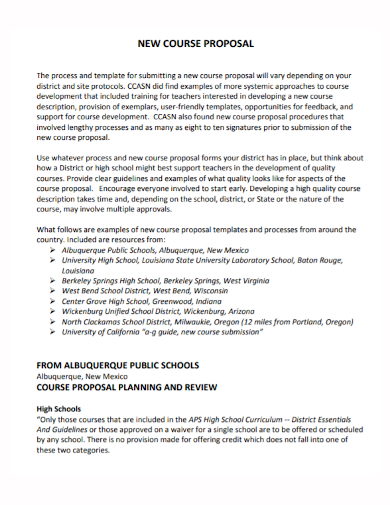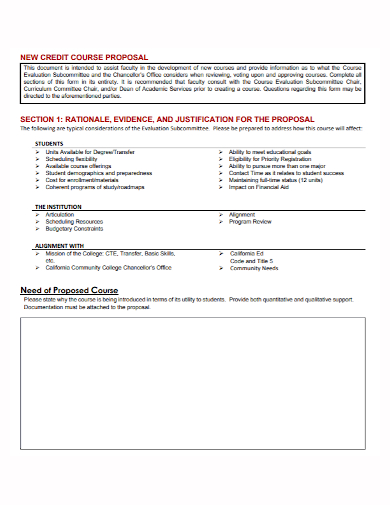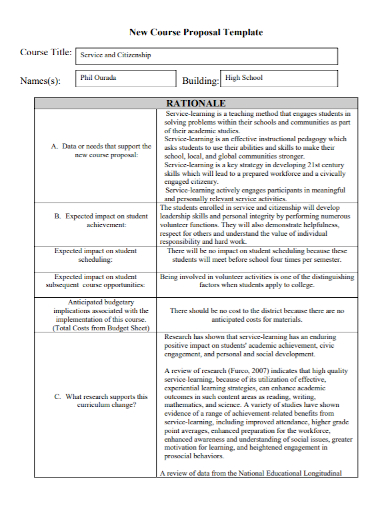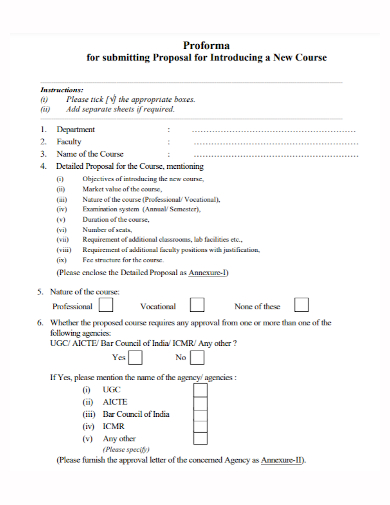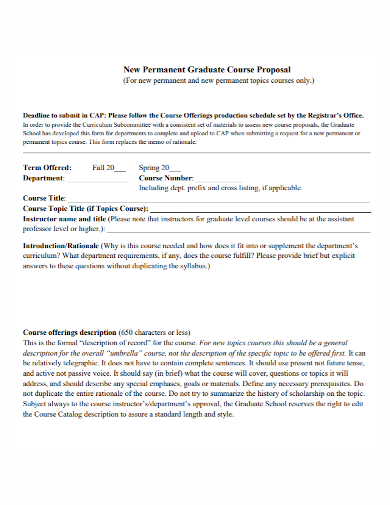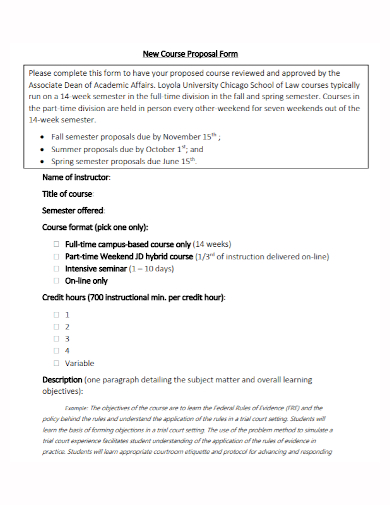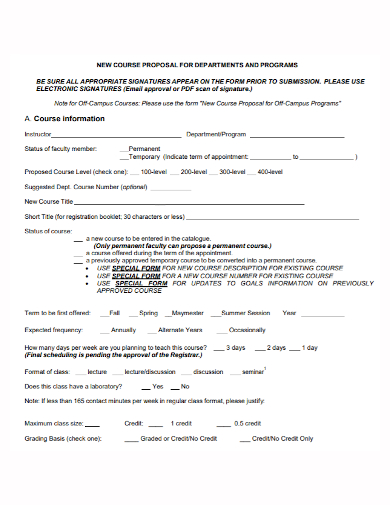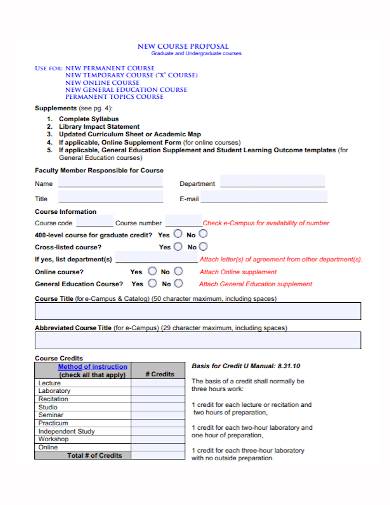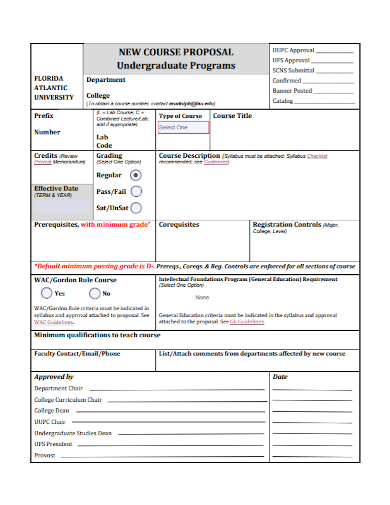Introducing a new course or even trying to revise a current one for the next academic year can come as a bit of a challenge. Yet introducing a new course to the curriculum can be advantageous for incoming students who may have the capacity to acquire a diverse amount of information, and allows them to gain exposure to a wide variety of disciplines. A handful of students do not have a clear idea of what they want to study and this exposure helps them to focus and, if they feel they are on the wrong track, switch from one field of study to another without much penalty in terms of time and money. So, to begin with a new course, one has to submit first a new course proposal for assessment and evaluation. Read more about this proposal in our article below and please do check out our free new course proposal samples as well.
10+ New Course Proposal Samples
1. New Course Proposal Template
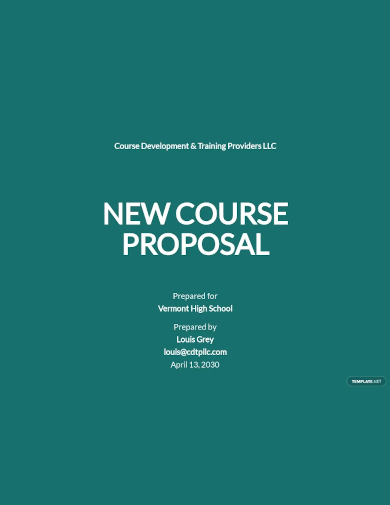
2. New Course Proposal
3. New Credit Course Proposal
4. Sample New Course Proposal
5. New Course Proposal Format
6. New Graduate Course Proposal
7. New Course Proposal Form
8. New Course Program Proposal
9. New Course Supplement Proposal
10. New Undergraduate Course Program Proposal
11. Editable New Course Proposal
What Is a New Course Proposal?
It isn’t new to the school system that students may often times shift or change their current course. Perhaps they might have find something better and suitable for them, or perhaps they have difficulties completing the current one. Whatever the reasons they may have, schools that offer a wide range of courses can be helpful to them since, shifting to a new course within the same school is less of an hassle than going to an entirely new one. The initial step in introducing a new course to the curriculum is by through a new course proposal. This is a written document designed to provide information of course’s purpose, content outline, learning outcomes and methods for assessing student learning. As you see a lot of things must be taken into consideration before you can start with your course proposal, so it is important to start planning early.
How To Write a New Course Proposal?
Developing a high quality course description takes time and, depending on the school, district, or the nature of the course, this may involve multiple approvals. Before you can initial begin, as mentioned there are a handful of things you need to examine before you can get your proposal into writing. Here are some of things to consider:
- Define the course goals. Having a clear set of goals will help you navigate through your proposal. This will enable you understand what you want the students to learn and accomplish. When you define the course goals, focus on student learning and content to include.
- Determine the course content. Decide on your course content by researching on various topics to be covered. Then start to develop the structure of the course; arrange the topics in a logical order. Developing a rationale that guides the structure of the course can help you explain the material more clearly to the students.
- You will also need to establish your teaching methods and the tools needed, in which must be consistent to the new course you are developing.
- Student evaluation: the process of evaluating your students must be aligned with the course goals.
- Course policies: develop the grading system, attendance and exam flow process.
- Course schedule : when preparing for your course schedule cross check with the school’s own calendar of activities for you to be able to map things well.
- Write the course syllabus. This should contain information about a specific course and explains the rules, responsibilities and expectations associated with it.
Although the the process and template for submitting a new course proposal will vary depending on the school district and site protocols, more or less the list below are the basic components that you may include in your new course proposal.
I. Course Subject and Number
The course subject is the area of study of a course, or the discipline within which the course is offered. This is identified by a three-letter course prefix that corresponds to that area of study or discipline. Selection of a course subject depends on the instructional focus of the course and the nature of the competencies addressed by the course. The number assigned to a course provides information about the level of knowledge covered in it and its relationship to other courses in the subject.
II. Character Title
Include the full name of the course title, and if acronyms are used in the title, they must be explained either in the title or in the course description, except in disciplines in which the acronym is a commonly understood usage.
III. Course Type
Define the proper course type if this an occupational or academic. Academic courses are those designed to provide general education and knowledge rather than a specific skill. Occupational courses are those that are designed to provide workforce readiness and to develop occupational or paraprofessional skills.
IV. Effectivity of Term and Year
Indicate the year and term when the course will be active.
V. Course Content, Learning Outcomes and Methods of Assessment
Under these section should be the topical outline, course and learning program outline, and the different methods of assessment.
VI. Resource Requirements
Identify the different resource requirements such as the rationale, course capacity, faculty load, library information requirements, technology and facilities requirements.
FAQs
How Do You Propose a School Class?
Start by listing the title of the course, prerequisites and the number of credits that can be earned. Indicate whether the class is required of certain majors or offered as an elective. It’s especially important to provide a solid rationale with evidence that there’s justification for the course.
How to Formulate Learning Outcomes?
Focus on the student–what the student will be able to do by the end of the course or program. Describe outcomes, not processes or activities.
What Are the Different Kinds of Course Proposals?
These are new permanent course, experimental course, course modification, independent study and course elimination.
Start writing your new course proposal now, don’t forget to follow the tips mentioned as you begin to formulate your proposal and do take note of the different components that should cover your new course proposal.
Related Posts
Proposal Samples
Sports Event Proposal Samples
Small Business Proposal Samples
Title Project Proposal Samples [ Community, School, Student ]
FREE 10+ Health Project Proposal Samples [ Public, Mental, Healthcare ]
FREE 11+ Engineering Project Proposal Samples in PDF | MS Word
FREE 4+ Racing Sponsorship Proposal Samples [ Team, Car, Driver ]
FREE 10+ Nursing Project Proposal Samples [ Community, Health, Clinical ]
FREE 11+ Student Council Proposal Samples in PDF | DOC
FREE 8+ Joint Venture Proposal Samples [ Commercial, Real Estate, Construction ]
FREE 10+ Scholarship Proposal Samples [ Project, Grant, Sponsorship ]
FREE 10+ Network Project Proposal Samples [ Design, Security, Bank ]
FREE 14+ Accounting Proposal Samples in PDF | MS Word
FREE 10+ Church Event Proposal Samples in MS Word | Google Docs | Apple Pages | PDF
FREE 10+ History Proposal Samples [ Dissertation, Thesis, Paper ]

